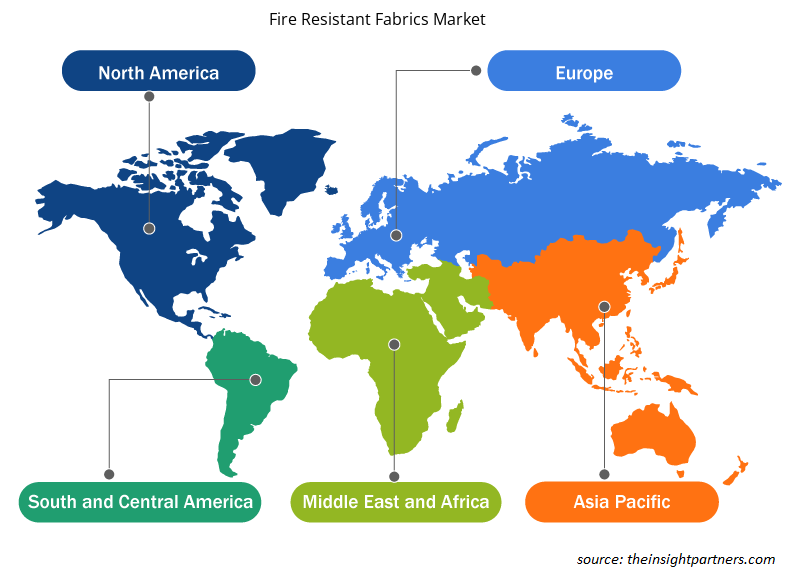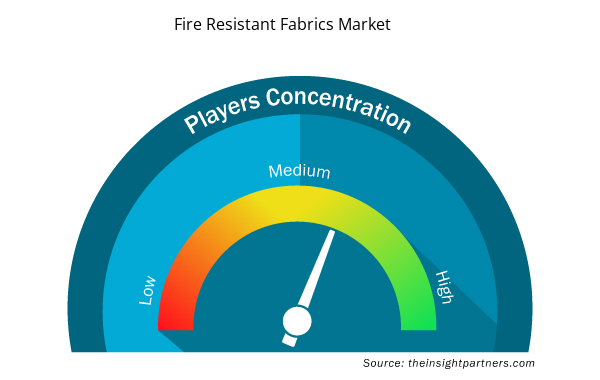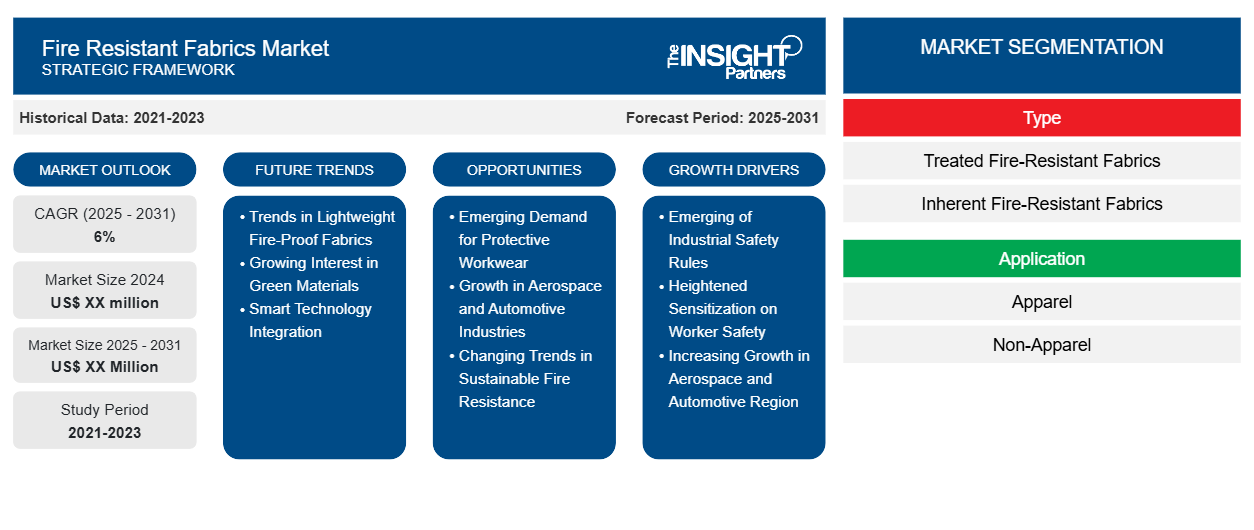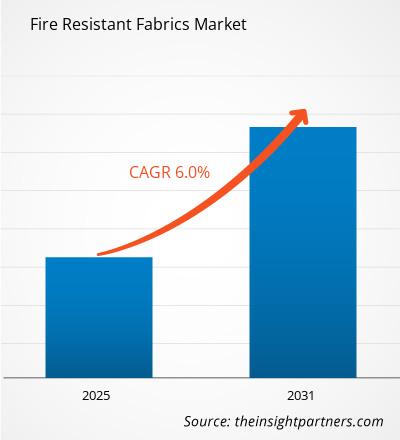Si prevede che il mercato dei tessuti ignifughi registrerà un CAGR del 6% dal 2024 al 2031, con una dimensione di mercato in espansione da XX milioni di dollari nel 2024 a XX milioni di dollari entro il 2031.
Il mercato dei tessuti ignifughi comprende l'analisi per tipo (tessuti ignifughi trattati, tessuti ignifughi intrinseci); applicazione (abbigliamento, non abbigliamento); uso finale (servizi di difesa e sicurezza pubblica, edilizia e produzione, petrolio e gas, automotive e trasporti, altri) e geografia (Nord America, Europa, Asia Pacifico, Medio Oriente e Africa e Sud e Centro America). I tessuti ignifughi sono fondamentalmente utilizzati in molte applicazioni come uniformi antincendio, trasporti, abiti da lavoro, servizi di polizia e arredamento residenziale e commerciale. Un costante miglioramento delle tecnologie abbinato a rigide normative imposte dal governo ha ulteriormente portato a un aumento dell'uso di tessuti ignifughi in vari settori di utilizzo finale.
Scopo del rapporto
Il report Fire Resistant Fabrics Market di The Insight Partners mira a descrivere il panorama attuale e la crescita futura, i principali fattori trainanti, le sfide e le opportunità. Ciò fornirà spunti a vari stakeholder aziendali, come:
- Fornitori/produttori di tecnologia: per comprendere le dinamiche di mercato in evoluzione e conoscere le potenziali opportunità di crescita, consentendo loro di prendere decisioni strategiche informate.
- Investitori: condurre un'analisi completa delle tendenze in merito al tasso di crescita del mercato, alle proiezioni finanziarie del mercato e alle opportunità esistenti lungo la catena del valore.
- Enti di regolamentazione: regolamentano le politiche e le attività di controllo sul mercato allo scopo di ridurre al minimo gli abusi, preservare la fiducia degli investitori e sostenere l'integrità e la stabilità del mercato.
Segmentazione del mercato dei tessuti ignifughi
Tipo
- Tessuti ignifughi trattati
- Tessuti ignifughi intrinseci
Applicazione
- Abbigliamento
- Non-abbigliamento
Uso finale
- Servizi di difesa e sicurezza pubblica
- Costruzione e produzione
- Petrolio e gas
- Automotive e trasporti
Geografia
- America del Nord
- Europa
- Asia-Pacifico
- America del Sud e Centro
- Medio Oriente e Africa
Personalizza questo report in base alle tue esigenze
Riceverai la personalizzazione gratuita di qualsiasi report, comprese parti di questo report, o analisi a livello nazionale, pacchetto dati Excel, oltre a usufruire di grandi offerte e sconti per start-up e università
- Scopri le principali tendenze di mercato in questo rapporto.Questo campione GRATUITO includerà analisi di dati che spaziano dalle tendenze di mercato alle stime e alle previsioni.
Fattori trainanti della crescita del mercato dei tessuti ignifughi
- Emergenza di norme di sicurezza industriale: la domanda di tessuti ignifughi è in aumento con l'aumento delle norme di sicurezza in settori quali la produzione, il petrolio e il gas e l'aerospaziale. I tessuti ignifughi sono richiesti in indumenti protettivi, isolanti e attrezzature per soddisfare rigorosi standard antincendio e per garantire la sicurezza delle persone in ambienti di lavoro pericolosi.
- Maggiore sensibilizzazione sulla sicurezza dei lavoratori: è questa consapevolezza che c'è una maggiore consapevolezza verso la sicurezza per i lavoratori nella maggior parte dei settori ad alto rischio. Quindi, ha alimentato la necessità di tessuti ignifughi utilizzati in indumenti protettivi, come uniformi, guanti e tute per i lavoratori che ora sono meglio protetti dai rischi di incendio in settori come l'edilizia e le costruzioni o l'energia.
- Crescita crescente nella regione aerospaziale e automobilistica: questa spinta dei produttori aeronautici e automobilistici verso una maggiore sicurezza e prestazioni è ciò che crea realmente la domanda di tessuti ignifughi. È nell'isolamento, nei rivestimenti dei sedili e in altri componenti protettivi utilizzati nei veicoli e negli aeromobili per migliorare gli standard di sicurezza antincendio e la conformità alle classificazioni.
Tendenze future del mercato dei tessuti ignifughi
- Tendenze nei tessuti ignifughi leggeri: in particolare, i tessuti ignifughi più leggeri e confortevoli sono di tendenza sul mercato. I produttori stanno perseguendo lo sviluppo di tali materiali per la massima protezione con il minimo peso, un maggiore comfort e una migliore mobilità in settori come la lotta antincendio, l'edilizia e l'aerospaziale senza compromettere la sicurezza.
- Crescente interesse per i materiali ecologici: c'è una tendenza crescente per i materiali ecologici nei tessuti ignifughi. I produttori inizieranno presto a ricercare possibilità utilizzando fibre riciclabili e tecnologie di finitura ignifughe naturali oltre a raggiungere la soglia di sicurezza antincendio per soddisfare la crescente domanda del settore di prodotti ecologicamente responsabili in settori come la moda e l'abbigliamento protettivo.
- Integrazione della tecnologia intelligente: la prognosi per i cambiamenti nel mercato tessile ignifugo si basa sugli sviluppi collegati alle tecnologie intelligenti. I tipi di tessuti come quelli con sensori o rivestimenti avanzati speciali saranno in grado di rilevare calore o fuoco e fornire altre forme di protezione. Queste sono innovazioni che promettono di apportare cambiamenti reali nell'abbigliamento antincendio.
Opportunità di mercato per tessuti ignifughi
- Domanda emergente di indumenti protettivi da lavoro: c'è una crescente opportunità per tessuti ignifughi negli indumenti protettivi da lavoro, poiché settori come petrolio e gas, estrazione mineraria ed edilizia attribuiscono sempre più importanza alla sicurezza dei dipendenti. I tessuti ignifughi diventano dispositivi di protezione individuale (DPI) di base, aumentando così la domanda di materiali durevoli e ad alte prestazioni in ambienti di lavoro pericolosi.
- Crescita nei settori aerospaziale e automobilistico: i tessuti ignifughi hanno grandi opportunità nei settori aerospaziale e automobilistico in rapida crescita. Gli standard di sicurezza antincendio sono piuttosto rigidi per quanto riguarda isolamento, tappezzeria e dispositivi di protezione individuale nella produzione di aeromobili e automobili. Con una crescente enfasi sulla sicurezza dei passeggeri e una conformità più rigorosa alle normative, la domanda di tali materiali mostra un mercato in crescita in futuro.
- Cambiamenti nelle tendenze della resistenza al fuoco sostenibile: l'angolo delle opportunità dei tessuti ignifughi in linea con l'attuale paradigma in evoluzione è quello dello sviluppo di soluzioni ecologiche. I tessuti ignifughi riciclati o biodegradabili hanno un valore per il consumatore attento all'ambiente, in vista dell'attuale tendenza verso l'uso di materiali sostenibili.
Approfondimenti regionali sul mercato dei tessuti ignifughi
Le tendenze regionali e i fattori che influenzano il mercato dei tessuti ignifughi durante il periodo di previsione sono stati ampiamente spiegati dagli analisti di Insight Partners. Questa sezione discute anche i segmenti e la geografia del mercato dei tessuti ignifughi in Nord America, Europa, Asia Pacifico, Medio Oriente e Africa e America meridionale e centrale.

- Ottieni i dati specifici regionali per il mercato dei tessuti ignifughi
Ambito del rapporto di mercato sui tessuti ignifughi
| Attributo del report | Dettagli |
|---|---|
| Dimensioni del mercato nel 2024 | XX milioni di dollari USA |
| Dimensioni del mercato entro il 2031 | XX milioni di dollari USA |
| CAGR globale (2025 - 2031) | 6% |
| Dati storici | 2021-2023 |
| Periodo di previsione | 2025-2031 |
| Segmenti coperti | Per tipo
|
| Regioni e Paesi coperti | America del Nord
|
| Leader di mercato e profili aziendali chiave |
|
Densità dei player del mercato dei tessuti ignifughi: comprendere il suo impatto sulle dinamiche aziendali
Il mercato dei tessuti ignifughi sta crescendo rapidamente, spinto dalla crescente domanda degli utenti finali dovuta a fattori quali l'evoluzione delle preferenze dei consumatori, i progressi tecnologici e una maggiore consapevolezza dei vantaggi del prodotto. Con l'aumento della domanda, le aziende stanno ampliando le loro offerte, innovando per soddisfare le esigenze dei consumatori e capitalizzando sulle tendenze emergenti, il che alimenta ulteriormente la crescita del mercato.
La densità degli operatori di mercato si riferisce alla distribuzione di aziende o società che operano in un particolare mercato o settore. Indica quanti concorrenti (operatori di mercato) sono presenti in un dato spazio di mercato in relazione alle sue dimensioni o al valore di mercato totale.
Le principali aziende che operano nel mercato dei tessuti ignifughi sono:
- EI Dupont De Nemours e Società
- Società per azioni Gun Ei Chemical Industry Co., Ltd.
- Società per azioni Huntsman
- Società Kaneka
- Lenzing AG
Disclaimer : le aziende elencate sopra non sono classificate secondo un ordine particolare.

- Ottieni una panoramica dei principali attori del mercato dei tessuti ignifughi
Punti di forza chiave
- Copertura completa: il rapporto copre in modo completo l'analisi di prodotti, servizi, tipologie e utenti finali del mercato dei tessuti ignifughi, fornendo una panoramica olistica.
- Analisi degli esperti: il rapporto è compilato sulla base della conoscenza approfondita di esperti e analisti del settore.
- Informazioni aggiornate: il rapporto garantisce la pertinenza aziendale grazie alla copertura di informazioni recenti e tendenze nei dati.
- Opzioni di personalizzazione: questo report può essere personalizzato per soddisfare le esigenze specifiche del cliente e adattarsi in modo appropriato alle strategie aziendali.
Il rapporto di ricerca sul mercato dei tessuti resistenti al fuoco può, quindi, aiutare a guidare il percorso di decodifica e comprensione dello scenario del settore e delle prospettive di crescita. Sebbene possano esserci alcune preoccupazioni valide, i vantaggi complessivi di questo rapporto tendono a superare gli svantaggi.
- Analisi storica (2 anni), anno base, previsione (7 anni) con CAGR
- Analisi PEST e SWOT
- Valore/volume delle dimensioni del mercato - Globale, regionale, nazionale
- Industria e panorama competitivo
- Set di dati Excel



Report Coverage
Revenue forecast, Company Analysis, Industry landscape, Growth factors, and Trends

Segment Covered
This text is related
to segments covered.

Regional Scope
North America, Europe, Asia Pacific, Middle East & Africa, South & Central America

Country Scope
This text is related
to country scope.
Domande frequenti
The North America market is expected to account for the highest CAGR during the forecast period owing to the growing aerospace industry in the region.
The defense and public safety services end use segment accounted for the largest market share in 2023.
E. I. Dupont De Nemours and Company, Gun Ei Chemical Industry Co., Ltd, Huntsman Corporation, Kaneka Corporation, Lenzing AG, PBI Performance Products Inc., Royal Tencate N.V., Solvay S.A., Teijin Ltd, and Westex By Milliken are some of the key players in the market.
Growing aerospace industry is a key driver in the market
The Fire Resistant Fabrics Market is estimated to witness a CAGR of 6% from 2023 to 2031
Growng miltary spending is an emerging trend in the market
Trends and growth analysis reports related to Chemicals and Materials : READ MORE..
The List of Companies
1. E. I. Dupont De Nemours and Company
2. Gun Ei Chemical Industry Co., Ltd.
3. Huntsman Corporation
4. Kaneka Corporation
5. Lenzing AG
6. PBI Performance Products Inc.
7. Royal Tencate N.V.
8. Solvay S.A.
9. Teijin Ltd.
10. Westex By Milliken
The Insight Partners performs research in 4 major stages: Data Collection & Secondary Research, Primary Research, Data Analysis and Data Triangulation & Final Review.
- Data Collection and Secondary Research:
As a market research and consulting firm operating from a decade, we have published and advised several client across the globe. First step for any study will start with an assessment of currently available data and insights from existing reports. Further, historical and current market information is collected from Investor Presentations, Annual Reports, SEC Filings, etc., and other information related to company’s performance and market positioning are gathered from Paid Databases (Factiva, Hoovers, and Reuters) and various other publications available in public domain.
Several associations trade associates, technical forums, institutes, societies and organization are accessed to gain technical as well as market related insights through their publications such as research papers, blogs and press releases related to the studies are referred to get cues about the market. Further, white papers, journals, magazines, and other news articles published in last 3 years are scrutinized and analyzed to understand the current market trends.
- Primary Research:
The primarily interview analysis comprise of data obtained from industry participants interview and answers to survey questions gathered by in-house primary team.
For primary research, interviews are conducted with industry experts/CEOs/Marketing Managers/VPs/Subject Matter Experts from both demand and supply side to get a 360-degree view of the market. The primary team conducts several interviews based on the complexity of the markets to understand the various market trends and dynamics which makes research more credible and precise.
A typical research interview fulfils the following functions:
- Provides first-hand information on the market size, market trends, growth trends, competitive landscape, and outlook
- Validates and strengthens in-house secondary research findings
- Develops the analysis team’s expertise and market understanding
Primary research involves email interactions and telephone interviews for each market, category, segment, and sub-segment across geographies. The participants who typically take part in such a process include, but are not limited to:
- Industry participants: VPs, business development managers, market intelligence managers and national sales managers
- Outside experts: Valuation experts, research analysts and key opinion leaders specializing in the electronics and semiconductor industry.
Below is the breakup of our primary respondents by company, designation, and region:

Once we receive the confirmation from primary research sources or primary respondents, we finalize the base year market estimation and forecast the data as per the macroeconomic and microeconomic factors assessed during data collection.
- Data Analysis:
Once data is validated through both secondary as well as primary respondents, we finalize the market estimations by hypothesis formulation and factor analysis at regional and country level.
- Macro-Economic Factor Analysis:
We analyse macroeconomic indicators such the gross domestic product (GDP), increase in the demand for goods and services across industries, technological advancement, regional economic growth, governmental policies, the influence of COVID-19, PEST analysis, and other aspects. This analysis aids in setting benchmarks for various nations/regions and approximating market splits. Additionally, the general trend of the aforementioned components aid in determining the market's development possibilities.
- Country Level Data:
Various factors that are especially aligned to the country are taken into account to determine the market size for a certain area and country, including the presence of vendors, such as headquarters and offices, the country's GDP, demand patterns, and industry growth. To comprehend the market dynamics for the nation, a number of growth variables, inhibitors, application areas, and current market trends are researched. The aforementioned elements aid in determining the country's overall market's growth potential.
- Company Profile:
The “Table of Contents” is formulated by listing and analyzing more than 25 - 30 companies operating in the market ecosystem across geographies. However, we profile only 10 companies as a standard practice in our syndicate reports. These 10 companies comprise leading, emerging, and regional players. Nonetheless, our analysis is not restricted to the 10 listed companies, we also analyze other companies present in the market to develop a holistic view and understand the prevailing trends. The “Company Profiles” section in the report covers key facts, business description, products & services, financial information, SWOT analysis, and key developments. The financial information presented is extracted from the annual reports and official documents of the publicly listed companies. Upon collecting the information for the sections of respective companies, we verify them via various primary sources and then compile the data in respective company profiles. The company level information helps us in deriving the base number as well as in forecasting the market size.
- Developing Base Number:
Aggregation of sales statistics (2020-2022) and macro-economic factor, and other secondary and primary research insights are utilized to arrive at base number and related market shares for 2022. The data gaps are identified in this step and relevant market data is analyzed, collected from paid primary interviews or databases. On finalizing the base year market size, forecasts are developed on the basis of macro-economic, industry and market growth factors and company level analysis.
- Data Triangulation and Final Review:
The market findings and base year market size calculations are validated from supply as well as demand side. Demand side validations are based on macro-economic factor analysis and benchmarks for respective regions and countries. In case of supply side validations, revenues of major companies are estimated (in case not available) based on industry benchmark, approximate number of employees, product portfolio, and primary interviews revenues are gathered. Further revenue from target product/service segment is assessed to avoid overshooting of market statistics. In case of heavy deviations between supply and demand side values, all thes steps are repeated to achieve synchronization.
We follow an iterative model, wherein we share our research findings with Subject Matter Experts (SME’s) and Key Opinion Leaders (KOLs) until consensus view of the market is not formulated – this model negates any drastic deviation in the opinions of experts. Only validated and universally acceptable research findings are quoted in our reports.
We have important check points that we use to validate our research findings – which we call – data triangulation, where we validate the information, we generate from secondary sources with primary interviews and then we re-validate with our internal data bases and Subject matter experts. This comprehensive model enables us to deliver high quality, reliable data in shortest possible time.


 Ottieni un campione gratuito per questo repot
Ottieni un campione gratuito per questo repot